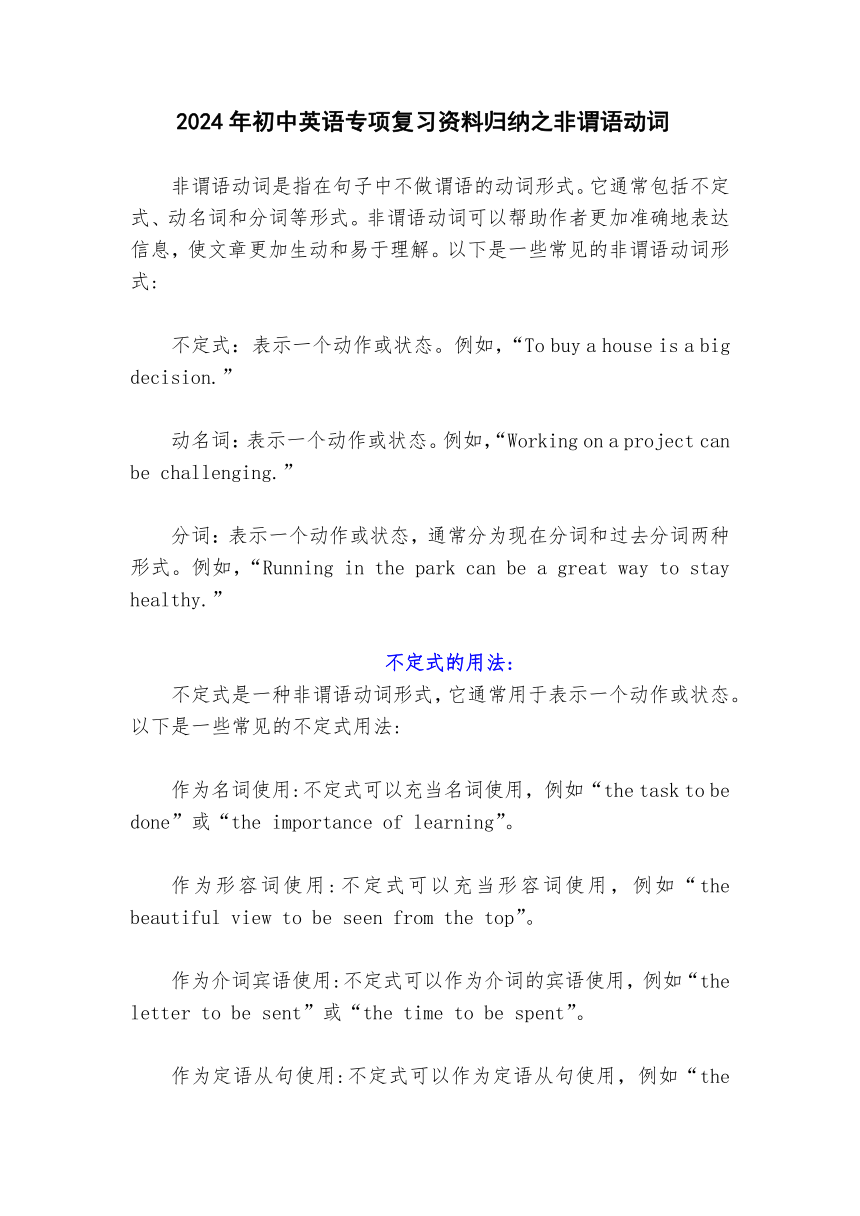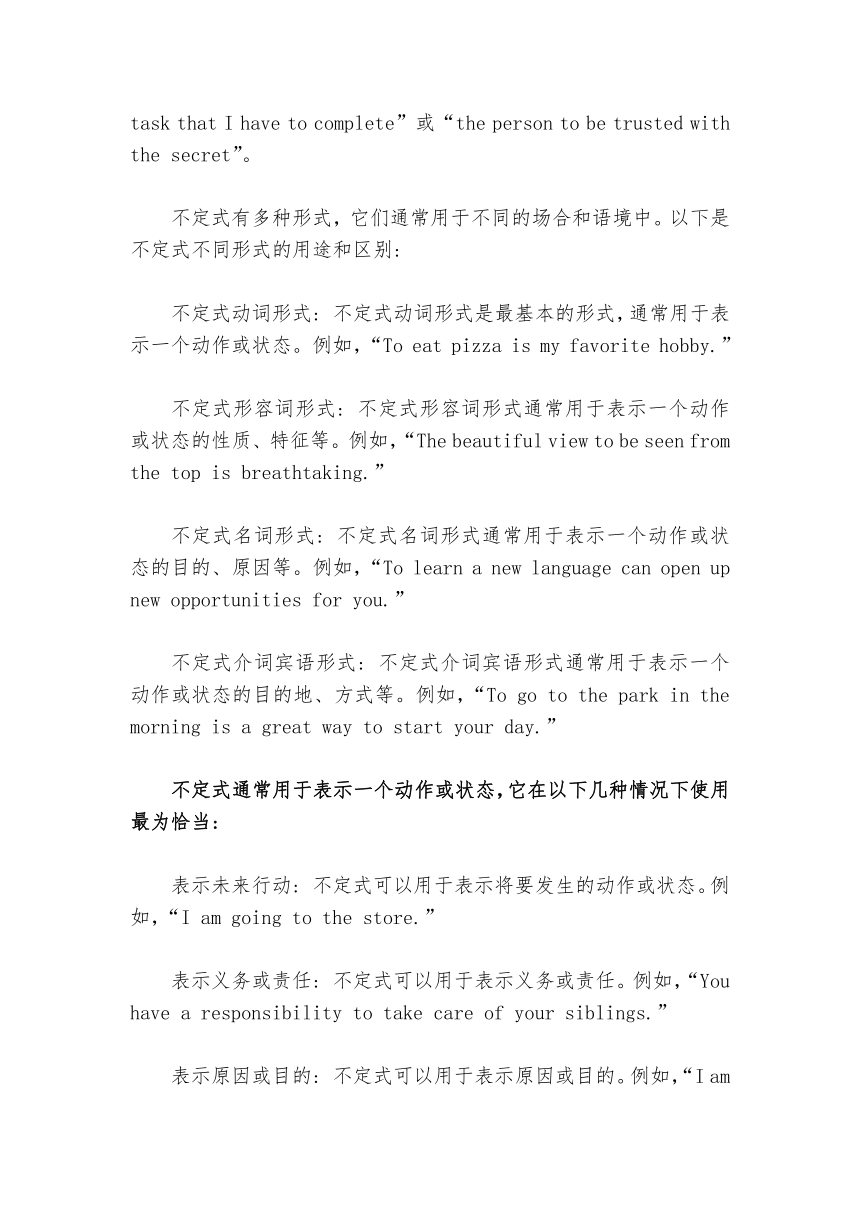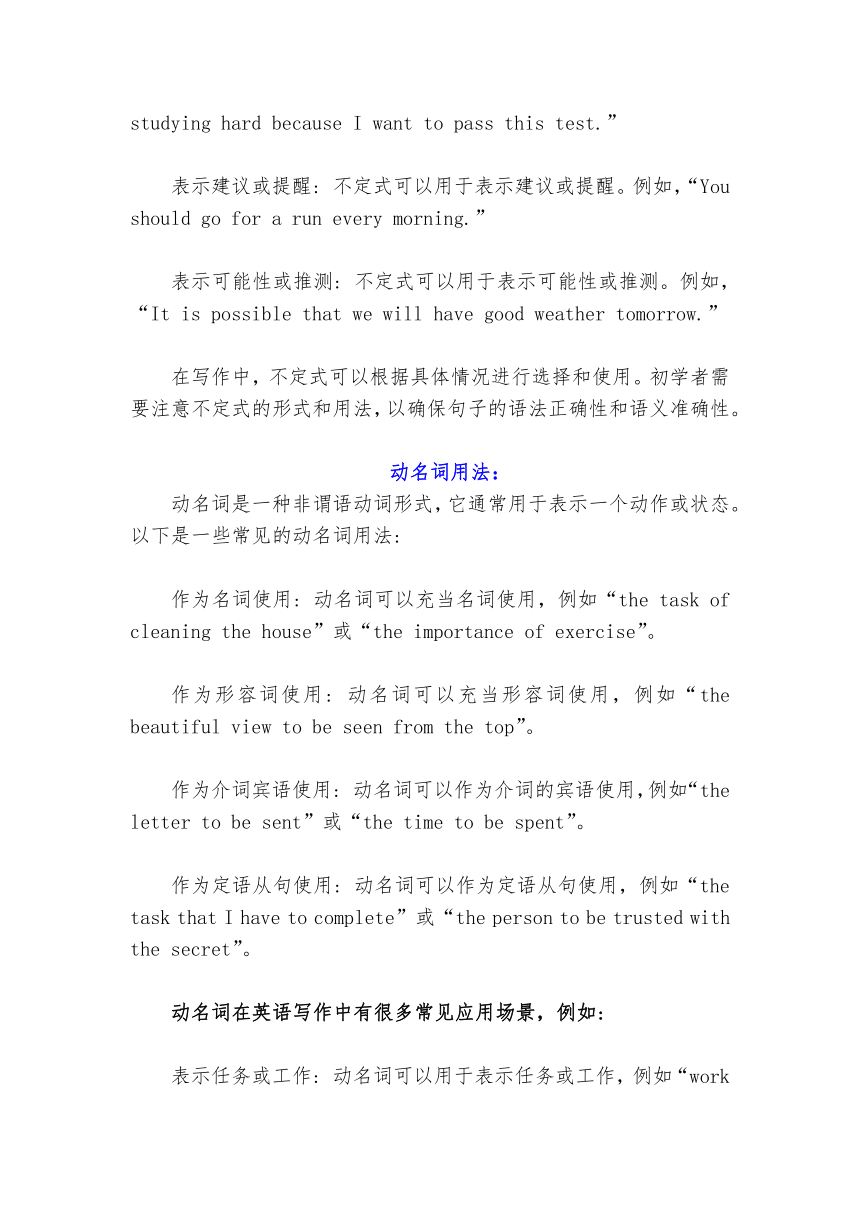2024年初中英语专项复习资料归纳之非谓语动词讲义
文档属性
| 名称 | 2024年初中英语专项复习资料归纳之非谓语动词讲义 |

|
|
| 格式 | docx | ||
| 文件大小 | 15.1KB | ||
| 资源类型 | 教案 | ||
| 版本资源 | 通用版 | ||
| 科目 | 英语 | ||
| 更新时间 | 2023-11-07 22:31:59 | ||
图片预览



文档简介
2024年初中英语专项复习资料归纳之非谓语动词
非谓语动词是指在句子中不做谓语的动词形式。它通常包括不定式、动名词和分词等形式。非谓语动词可以帮助作者更加准确地表达信息,使文章更加生动和易于理解。以下是一些常见的非谓语动词形式:
不定式:表示一个动作或状态。例如,“To buy a house is a big decision.”
动名词:表示一个动作或状态。例如,“Working on a project can be challenging.”
分词:表示一个动作或状态,通常分为现在分词和过去分词两种形式。例如,“Running in the park can be a great way to stay healthy.”
不定式的用法:
不定式是一种非谓语动词形式,它通常用于表示一个动作或状态。以下是一些常见的不定式用法:
作为名词使用:不定式可以充当名词使用,例如“the task to be done”或“the importance of learning”。
作为形容词使用:不定式可以充当形容词使用,例如“the beautiful view to be seen from the top”。
作为介词宾语使用:不定式可以作为介词的宾语使用,例如“the letter to be sent”或“the time to be spent”。
作为定语从句使用:不定式可以作为定语从句使用,例如“the task that I have to complete”或“the person to be trusted with the secret”。
不定式有多种形式,它们通常用于不同的场合和语境中。以下是不定式不同形式的用途和区别:
不定式动词形式: 不定式动词形式是最基本的形式,通常用于表示一个动作或状态。例如,“To eat pizza is my favorite hobby.”
不定式形容词形式: 不定式形容词形式通常用于表示一个动作或状态的性质、特征等。例如,“The beautiful view to be seen from the top is breathtaking.”
不定式名词形式: 不定式名词形式通常用于表示一个动作或状态的目的、原因等。例如,“To learn a new language can open up new opportunities for you.”
不定式介词宾语形式: 不定式介词宾语形式通常用于表示一个动作或状态的目的地、方式等。例如,“To go to the park in the morning is a great way to start your day.”
不定式通常用于表示一个动作或状态,它在以下几种情况下使用最为恰当:
表示未来行动: 不定式可以用于表示将要发生的动作或状态。例如,“I am going to the store.”
表示义务或责任: 不定式可以用于表示义务或责任。例如,“You have a responsibility to take care of your siblings.”
表示原因或目的: 不定式可以用于表示原因或目的。例如,“I am studying hard because I want to pass this test.”
表示建议或提醒: 不定式可以用于表示建议或提醒。例如,“You should go for a run every morning.”
表示可能性或推测: 不定式可以用于表示可能性或推测。例如,“It is possible that we will have good weather tomorrow.”
在写作中,不定式可以根据具体情况进行选择和使用。初学者需要注意不定式的形式和用法,以确保句子的语法正确性和语义准确性。
动名词用法:
动名词是一种非谓语动词形式,它通常用于表示一个动作或状态。以下是一些常见的动名词用法:
作为名词使用: 动名词可以充当名词使用,例如“the task of cleaning the house”或“the importance of exercise”。
作为形容词使用: 动名词可以充当形容词使用,例如“the beautiful view to be seen from the top”。
作为介词宾语使用: 动名词可以作为介词的宾语使用,例如“the letter to be sent”或“the time to be spent”。
作为定语从句使用: 动名词可以作为定语从句使用,例如“the task that I have to complete”或“the person to be trusted with the secret”。
动名词在英语写作中有很多常见应用场景,例如:
表示任务或工作: 动名词可以用于表示任务或工作,例如“work hard”或“do some cleaning”。
表示活动或娱乐: 动名词可以用于表示活动或娱乐,例如“play basketball”或“read a book”。
表示状态或感受: 动名词可以用于表示状态或感受,例如“be happy”或“feel tired”。
表示习惯或惯例: 动名词可以用于表示习惯或惯例,例如“eat breakfast every morning”或“take a shower before work”。
表示原因或理由: 动名词可以用于表示原因或理由,例如“because of the bad weather”或“because I didn't want to go”.
分词的用法:
分词是一种非谓语动词形式,它通常用于表示一个动作或状态。以下是一些常见的分词用法:
现在分词: 现在分词可以表示正在进行的动作或状态。例如,“he is running”或“the car is driving”.
过去分词: 过去分词可以表示已经完成的动作或状态。例如,“he had finished his work”或“the house was built long ago”.
进行时态: 进行时态通常用于表示正在进行的动作或状态。例如,“he is currently working”或“she is currently studying”.
被动语态: 被动语态通常用于表示动作的承受者或对象。例如,“the letter was written by her”或“the house was built by the architect”.
形容词: 现在分词有时也可以充当形容词使用,用于描述名词的性质或特征。例如,“this room is warm and cozy”或“the book is interesting and informative”.
介词短语: 现在分词有时也可以充当介词短语使用,用于表示动作的方式或目的地。例如,“he is running to the store”或“the car is driving to the hospital”.
分词在英语写作中有很多应用场景,例如:
表示动作或状态: 现在分词可以用于表示正在进行的动作或状态,例如“he is running”或“the car is driving”。
描述名词的性质或特征: 现在分词有时也可以充当形容词使用,用于描述名词的性质或特征,例如“this room is warm and cozy”或“the book is interesting and informative”。
作为介词短语: 现在分词有时也可以充当介词短语使用,用于表示动作的方式或目的地,例如“he is running to the store”或“the car is driving to the hospital”。
表示原因或理由: 现在分词可以用于表示原因或理由,例如“because of the bad weather”或“because I didn't want to go”。
表示习惯或惯例: 动名词可以用于表示习惯或惯例,例如“eat breakfast every morning”或“take a shower before work”。
表示可能性或推测: 动名词可以用于表示可能性或推测,例如“it is possible that we will have good weather tomorrow”或“she might be coming to the party tonight”。
表示定语: 现在分词可以作为定语修饰一个名词或代词,例如“a running car”或“a running man”。
作为独立主格结构: 现在分词可以作为独立主格结构使用,例如“I am running”或“my car is running well”。
以下是几个分词用法易错点:
动词+ing形式错误: 一些动词需要使用不定式形式而不是分词形式。例如, try(尝试), want(想要)等。
非主动词使用分词: 如果分词不是作为谓语或动词的一部分使用,则应该使用非主动词形式。例如, running(跑步)而不是running(跑步)。
错误的时态: 分词的时态应与主句的时态保持一致。例如, he is running (现在进行时), not he is running (现在时)。
错误的主语形式: 在使用现在分词时,主语应为第三人称单数形式。例如, the dog is running(狗在跑步),not the dog is running(狗在跑步)。
错误的被动语态形式: 在使用现在分词作为被动语态时,应在动词后面加上-ed。例如, the house is being built(房子正在被建造),not the house is being built(房子正在被建造)。
错误的修饰语位置: 在修饰语位于名词之前的情况下,应使用现在分词而非过去分词。例如, the running man(跑步的人),not the running man(跑步的人)。
非谓语动词可以作为状语的几种情况如下:
作为时间状语: 表示动作发生的时间,例如:
She is running to the store. (她正在去商店的路上)
He is playing basketball. (他正在打篮球)
作为地点状语: 表示动作发生的地点,例如:
They are going to the park tomorrow. (他们明天要去公园)
I am at home now. (我现在在家里)
作为原因状语: 表示动作发生的原因或依据,例如:
She is studying hard for the exam. (她在为考试努力学习)
They are waiting for us. (他们在等我们)
作为方式状语: 表示动作发生的方式或方法,例如:
He is studying medicine. (他正在学习医学)
We are watching a movie. (我们在看电影)
作为结果状语: 表示动作发生的结果或影响,例如:
She is happy today. (她今天很开心)
The sun is shining brightly today. (今天阳光明媚)
需要注意的是,非谓语动词作为状语时通常要使用副词形式,如after, before, during, because of等。
非谓语动词是指在句子中不做谓语的动词形式。它通常包括不定式、动名词和分词等形式。非谓语动词可以帮助作者更加准确地表达信息,使文章更加生动和易于理解。以下是一些常见的非谓语动词形式:
不定式:表示一个动作或状态。例如,“To buy a house is a big decision.”
动名词:表示一个动作或状态。例如,“Working on a project can be challenging.”
分词:表示一个动作或状态,通常分为现在分词和过去分词两种形式。例如,“Running in the park can be a great way to stay healthy.”
不定式的用法:
不定式是一种非谓语动词形式,它通常用于表示一个动作或状态。以下是一些常见的不定式用法:
作为名词使用:不定式可以充当名词使用,例如“the task to be done”或“the importance of learning”。
作为形容词使用:不定式可以充当形容词使用,例如“the beautiful view to be seen from the top”。
作为介词宾语使用:不定式可以作为介词的宾语使用,例如“the letter to be sent”或“the time to be spent”。
作为定语从句使用:不定式可以作为定语从句使用,例如“the task that I have to complete”或“the person to be trusted with the secret”。
不定式有多种形式,它们通常用于不同的场合和语境中。以下是不定式不同形式的用途和区别:
不定式动词形式: 不定式动词形式是最基本的形式,通常用于表示一个动作或状态。例如,“To eat pizza is my favorite hobby.”
不定式形容词形式: 不定式形容词形式通常用于表示一个动作或状态的性质、特征等。例如,“The beautiful view to be seen from the top is breathtaking.”
不定式名词形式: 不定式名词形式通常用于表示一个动作或状态的目的、原因等。例如,“To learn a new language can open up new opportunities for you.”
不定式介词宾语形式: 不定式介词宾语形式通常用于表示一个动作或状态的目的地、方式等。例如,“To go to the park in the morning is a great way to start your day.”
不定式通常用于表示一个动作或状态,它在以下几种情况下使用最为恰当:
表示未来行动: 不定式可以用于表示将要发生的动作或状态。例如,“I am going to the store.”
表示义务或责任: 不定式可以用于表示义务或责任。例如,“You have a responsibility to take care of your siblings.”
表示原因或目的: 不定式可以用于表示原因或目的。例如,“I am studying hard because I want to pass this test.”
表示建议或提醒: 不定式可以用于表示建议或提醒。例如,“You should go for a run every morning.”
表示可能性或推测: 不定式可以用于表示可能性或推测。例如,“It is possible that we will have good weather tomorrow.”
在写作中,不定式可以根据具体情况进行选择和使用。初学者需要注意不定式的形式和用法,以确保句子的语法正确性和语义准确性。
动名词用法:
动名词是一种非谓语动词形式,它通常用于表示一个动作或状态。以下是一些常见的动名词用法:
作为名词使用: 动名词可以充当名词使用,例如“the task of cleaning the house”或“the importance of exercise”。
作为形容词使用: 动名词可以充当形容词使用,例如“the beautiful view to be seen from the top”。
作为介词宾语使用: 动名词可以作为介词的宾语使用,例如“the letter to be sent”或“the time to be spent”。
作为定语从句使用: 动名词可以作为定语从句使用,例如“the task that I have to complete”或“the person to be trusted with the secret”。
动名词在英语写作中有很多常见应用场景,例如:
表示任务或工作: 动名词可以用于表示任务或工作,例如“work hard”或“do some cleaning”。
表示活动或娱乐: 动名词可以用于表示活动或娱乐,例如“play basketball”或“read a book”。
表示状态或感受: 动名词可以用于表示状态或感受,例如“be happy”或“feel tired”。
表示习惯或惯例: 动名词可以用于表示习惯或惯例,例如“eat breakfast every morning”或“take a shower before work”。
表示原因或理由: 动名词可以用于表示原因或理由,例如“because of the bad weather”或“because I didn't want to go”.
分词的用法:
分词是一种非谓语动词形式,它通常用于表示一个动作或状态。以下是一些常见的分词用法:
现在分词: 现在分词可以表示正在进行的动作或状态。例如,“he is running”或“the car is driving”.
过去分词: 过去分词可以表示已经完成的动作或状态。例如,“he had finished his work”或“the house was built long ago”.
进行时态: 进行时态通常用于表示正在进行的动作或状态。例如,“he is currently working”或“she is currently studying”.
被动语态: 被动语态通常用于表示动作的承受者或对象。例如,“the letter was written by her”或“the house was built by the architect”.
形容词: 现在分词有时也可以充当形容词使用,用于描述名词的性质或特征。例如,“this room is warm and cozy”或“the book is interesting and informative”.
介词短语: 现在分词有时也可以充当介词短语使用,用于表示动作的方式或目的地。例如,“he is running to the store”或“the car is driving to the hospital”.
分词在英语写作中有很多应用场景,例如:
表示动作或状态: 现在分词可以用于表示正在进行的动作或状态,例如“he is running”或“the car is driving”。
描述名词的性质或特征: 现在分词有时也可以充当形容词使用,用于描述名词的性质或特征,例如“this room is warm and cozy”或“the book is interesting and informative”。
作为介词短语: 现在分词有时也可以充当介词短语使用,用于表示动作的方式或目的地,例如“he is running to the store”或“the car is driving to the hospital”。
表示原因或理由: 现在分词可以用于表示原因或理由,例如“because of the bad weather”或“because I didn't want to go”。
表示习惯或惯例: 动名词可以用于表示习惯或惯例,例如“eat breakfast every morning”或“take a shower before work”。
表示可能性或推测: 动名词可以用于表示可能性或推测,例如“it is possible that we will have good weather tomorrow”或“she might be coming to the party tonight”。
表示定语: 现在分词可以作为定语修饰一个名词或代词,例如“a running car”或“a running man”。
作为独立主格结构: 现在分词可以作为独立主格结构使用,例如“I am running”或“my car is running well”。
以下是几个分词用法易错点:
动词+ing形式错误: 一些动词需要使用不定式形式而不是分词形式。例如, try(尝试), want(想要)等。
非主动词使用分词: 如果分词不是作为谓语或动词的一部分使用,则应该使用非主动词形式。例如, running(跑步)而不是running(跑步)。
错误的时态: 分词的时态应与主句的时态保持一致。例如, he is running (现在进行时), not he is running (现在时)。
错误的主语形式: 在使用现在分词时,主语应为第三人称单数形式。例如, the dog is running(狗在跑步),not the dog is running(狗在跑步)。
错误的被动语态形式: 在使用现在分词作为被动语态时,应在动词后面加上-ed。例如, the house is being built(房子正在被建造),not the house is being built(房子正在被建造)。
错误的修饰语位置: 在修饰语位于名词之前的情况下,应使用现在分词而非过去分词。例如, the running man(跑步的人),not the running man(跑步的人)。
非谓语动词可以作为状语的几种情况如下:
作为时间状语: 表示动作发生的时间,例如:
She is running to the store. (她正在去商店的路上)
He is playing basketball. (他正在打篮球)
作为地点状语: 表示动作发生的地点,例如:
They are going to the park tomorrow. (他们明天要去公园)
I am at home now. (我现在在家里)
作为原因状语: 表示动作发生的原因或依据,例如:
She is studying hard for the exam. (她在为考试努力学习)
They are waiting for us. (他们在等我们)
作为方式状语: 表示动作发生的方式或方法,例如:
He is studying medicine. (他正在学习医学)
We are watching a movie. (我们在看电影)
作为结果状语: 表示动作发生的结果或影响,例如:
She is happy today. (她今天很开心)
The sun is shining brightly today. (今天阳光明媚)
需要注意的是,非谓语动词作为状语时通常要使用副词形式,如after, before, during, because of等。
同课章节目录
- 词法
- 名词
- 动词和动词短语
- 动词语态
- 动词时态
- 助动词和情态动词
- 非谓语动词
- 冠词
- 代词
- 数词和量词
- 形容词副词及其比较等级
- 介词和介词短语
- 连词和感叹词
- 构词法
- 相似、相近词比较
- 句法
- 陈述句
- 一般疑问句和否定疑问句
- 特殊疑问句及选择疑问句
- 反意疑问句
- 存在句(There be句型)
- 宾语从句
- 定语从句
- 状语从句
- 主谓一致问题
- 简单句
- 并列句
- 复合句
- 主谓一致
- 主、表语从句
- 名词性从句
- 直接引语和间接引语
- 虚拟语气
- 感叹句
- 强调句
- 倒装句
- 祈使句
- 句子的成分
- 句子的分类
- 题型专区
- 单项选择部分
- 易错题
- 完形填空
- 阅读理解
- 词汇练习
- 听说训练
- 句型转换
- 补全对话
- 短文改错
- 翻译
- 书面表达
- 任务型阅读
- 语法填空
- 其他资料
